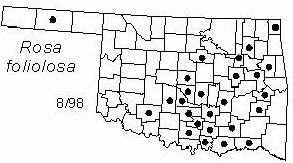Climbing vine or small shrub to 50 cm (20 in) tall. Twigs glabrous, prickles absent, or, if present, 8-12 mm (0.3-0.5 in) long, straight or reflexed. Leaves alternate, pinnately compound, with 5-11 leaflets (typically 9), leaflets oblong to linear-oblong; glabrous above, glabrous or pubescent along veins beneath, upper surface lustrous; acute at base and apex; margins finely serrate, rarely glandular ciliate; petioles very short, adnate, glabrous. Inflorescence typically a solitary flower; sepals 5, dorsally glandular-hispid, tomentose above, margins entire; petals 5, rose, obovate; styles distinct, but not exerted; stamens numerous; flowers appear from May to June. Fruit a hip, about 8 mm (0.3 in) in diameter, subglobose, red; nutlets numerous, ovoid, brown, with long dorsal pubescence; fruits mature in late July.
Distribution: Oklahoma, Arkansas, and Texas. Common in Oklahoma.
Habitat: woodlands and prairies.
Comment: Rosa is the classical name for roses; foliolosa refers to the many leaves.
Field identification: a good character is the slender leaflets, 9 per leaf. It is possible to confuse leafy rose with Carolina rose (Rosa carolina). Fewer prickles, shorter stipules, shorter petioles, and a leaflet length-width ratio of 3-1 are characters for distinguishing leafy rose.
Food uses: rose hips are an excellent source of vitamin C (60 times the concentration of lemons).
NWI status: none
Distribution in Oklahoma: 
BACK
NEXT
RETURN TO INDEX
Last update: 9/17/99
 Go to Oklahoma Biological Survey Home Page
Go to Oklahoma Biological Survey Home Page
 Disclaimer
Disclaimer